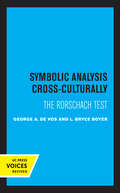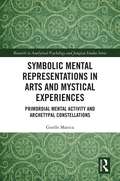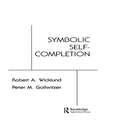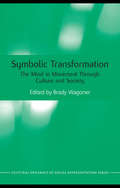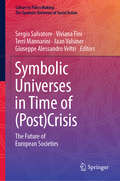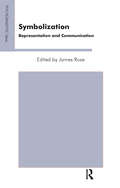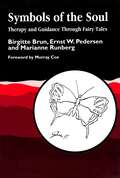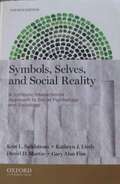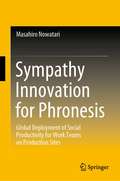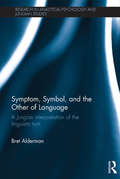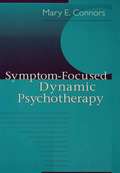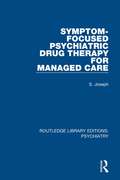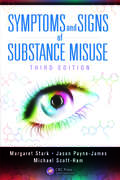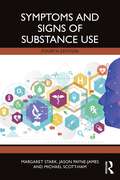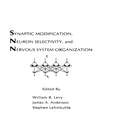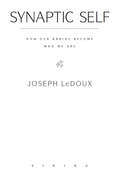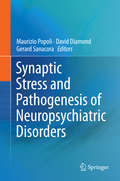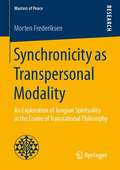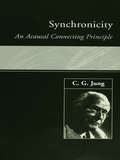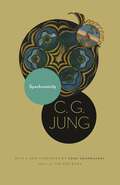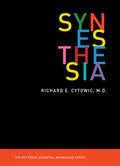- Table View
- List View
Symbolic Analysis Cross-Culturally: The Rorschach Test
by L. Bryce Boyer George A. De VosThis title is part of UC Press's Voices Revived program, which commemorates University of California Press’s mission to seek out and cultivate the brightest minds and give them voice, reach, and impact. Drawing on a backlist dating to 1893, Voices Revived makes high-quality, peer-reviewed scholarship accessible once again using print-on-demand technology. This title was originally published in 1989.
Symbolic Mental Representations in Arts and Mystical Experiences: Primordial Mental Activity and Archetypal Constellations (Research in Analytical Psychology and Jungian Studies)
by Giselle ManicaSymbolic Mental Representations in Arts and Mystical Experiences explains how the individual’s conceptualization of reality is dependent on the development of their brain, body structure, and the experiences that are physiologically confronted, acted, or observed via learning and/or simulation, occurring in family or community settings. The book offers support for Jean Knox’s reinterpretation of Jung's archetypal hypothesis, exposing the fundamentality of the body – in its neurophysiological development, bodily-felt sensations, non-verbal interactions, affects, emotions, and actions – in the process of meaning-making. Using information from disciplines such as Affective Neuroscience, Embodied Cognition, Attachment Theory, and Cognitive Linguistics, it clarifies how the most refined experiences of symbolic imagination are rooted in somatopsychic patterns. This book will be of great interest for academics and researchers in the fields of Analytical Psychology, Affective Neuroscience, Linguistics, Anthropology of Consciousness, Art-therapy, and Mystical Experiences, as well as Jungian and post-Jungian scholars, philosophers, and teachers.
Symbolic Self Completion
by R. A. Wicklund P. M. GollwitzerFirst published in 1982. Routledge is an imprint of Taylor & Francis, an informa company.
Symbolic Transformation: The Mind in Movement Through Culture and Society (Cultural Dynamics of Social Representation)
by Brady WagonerThis book brings together scholars from around the world to address the question of how culture and mind are related through symbols: it is through the mediation of symbols that we think, act, imagine, feel, dream and remember. Thus, to understand the structure, function and development of symbols is to understand what it means to be human. Part I of the book constructs a theoretical foundation in semiotics for thinking about symbols, and analyzes their place in speech, images, affect and evolution. Part II explores how our experience is transformed through symbols: why we are moved by a movie or political speech, how bread and wine can taste like Christ’s body and blood, and why our memories are forever changing. Part III focuses on symbols in the human life-course, particularly in connection with play, language and art. And lastly, Part IV explores how identities, such as being a sex-worker or HIV-positive, are constituted in social relationships through society’s symbols. This broad interdisciplinary synthesis on the problem of symbols is an essential resource for anyone studying culture in mind, including advanced students in psychology, semiotics, anthropology, communications and philosophy.
Symbolic Universes in Time of: The Future of European Societies (Culture in Policy Making: The Symbolic Universes of Social Action)
by Jaan Valsiner Sergio Salvatore Viviana Fini Terri Mannarini Giuseppe Alessandro VeltriThis book investigates whether, how and where the cultural milieu of European societies has changed as a result of the socio-economics crisis. To do so, it adopts a psycho-cultural approach, which views the cultural milieu as a set of meanings, placing the generalized image social actors have of themselves, the world, events and their relationships in the context of the socio-political and institutional environment, including policies. By analyzing the changes in cultural milieu and social identity, the book develops strategic and methodological guidelines for the design of post-crisis policies, providing a concept of how the cultural dynamics are associated with certain individual characteristics and specific socio-economic phenomena.
Symbolization: Representation and Communication (The\psychoanalytic Ideas Ser.)
by James RoseThis book traces the development of the understanding of symbols and their formation and use in its historical context, and discusses their clinical significance in psychoanalysis. It will be of relevance and use in the practical sense as well as the theoretical.
Symbols of Defeat in the Construction of National Identity
by Steven J. MockIf nationalism is the assertion of legitimacy for a nation and its effectiveness as a political entity, why do many nations emphasize images of their own defeat in understanding their history? Using Israel, Serbia, France, Greece, and Ghana as examples, the author argues that this phenomenon exposes the ambivalence that lurks behind the passions nationalism evokes. Symbols of defeat glorify a nation's ancient past, while reenacting the destruction of that past as a necessary step in constructing a functioning modern society. As a result, these symbols often assume a foundational role in national mythology. Threats to such symbols are perceived as threats to the nation itself and consequently are met with desperation difficult for outsiders to understand.
Symbols of the Soul: Therapy and Guidance Through Fairy Tales
by Birgitte Brun Ernst W Pedersen Murray Cox Marianne RunbergFairy tales are part of our culture and history. They have been with many of us since we were children. During the last 20 years there has been an increasing interest in psychoanalytically-orientated interpretation of fairy tales, opening them up as a medium for therapy. The authors show that fairy tales can be used in therapy and guidance in a number of ways and on many different levels. They found that using such stories in their daily work proved beneficial for staff-members and patients alike, generating a response of interest, attention and sensitivity, underlining their point that fairy tales have an impact on, and importance for, everyone.
Symbols, Selves, and Social Reality: A Symbolic Interactionist Approach to Social Psychology and Sociology
by Gary Alan Fine Kent L. Sandstrom Daniel D. Martin Kathryn J. LivelyThe fourth edition of Symbols, Selves, and Social Reality provides students with a succinct, engaging, and affordable introduction to symbolic interactionism--the perspective that social reality is created, negotiated, and changed through the process of social interaction. Focusing on how elements of race and gender affect identity, the authors use real-world examples to discuss the personal significance of symbolic interactionism, its expanding theoretical scope, and its relationship to other prominent perspectives in sociology and social psychology. They skillfully cover empirical research topics that are inherently interesting to students, such as the dynamics of self-development, impression management, identity transformation, gender play, rumor transmission, and collective action.
Symmetry Breaking in Syntax
by Hubert HaiderIn this illuminating new theory of grammar, Hubert Haider demonstrates that there is a basic asymmetry in the phrase structure of any language, whatever sentence structure it takes. Moreover, he argues that understanding this asymmetry is the key to understanding the grammatical causality underlying a broad range of core syntactic phenomena. Until now, Germanic languages have been seen to fall into two distinct classes: those which take an object-verb sentence structure (OV) or a verb-object one (VO). However, by examining the nature of this universal underlying asymmetry, Hubert Haider reveals a third syntactic type: 'Type III'. In particular, he employs the third type to explore the cognitive evolution of grammar which gave rise to the structural asymmetry and its typological implications. Symmetry Breaking in Syntax will appeal to academic researchers and graduate students involved in comparative and theoretical syntax and the cognitive evolution of grammar.
Sympathy Innovation for Phronesis: Global Deployment of Social Productivity for Work Teams on Production Sites
by Masahiro NowatariThis book explores social productivity in work teams on production sites, with an eye toward human welfare. It focuses especially on "sympathy management" by the use of multivariate analysis in a worldwide social survey. Manufacturing production sites have many work teams, and their activities support productivity. Productivity, however, is evaluated only by the production system. Therefore, the social system's sympathy evaluation as teamwork in the work team is completely disregarded by management activity. Management recognizes this social system and must upgrade teamwork as a social system from tacit to explicit knowledge as an appraisal system. Thus, this new paradigm significantly contributes to industrial society beyond conventional management. The work team's social system functions in a production system and affects team productivity. Therefore, it must take a bird's-eye view of social productivity as an overall strategy. Social productivity has two appraisal criteria, the social system's sympathy and the production system's productivity. Increasing explicit knowledge of sympathy as teamwork requires the perspective of human-social science. Social productivity has been verified through global deployment by social research and case studies and contributes to humankind's welfare on sustainable development goals and ISO56000, an innovation management system. Social productivity can also decrease opportunity loss based on ignoring the social system of the work team.
Symptom, Symbol, and the Other of Language: A Jungian Interpretation of the Linguistic Turn (Research in Analytical Psychology and Jungian Studies)
by Bret AldermanEvery statement about language is also a statement by and about psyche. Guided by this primary assumption, and inspired by the works of Carl Jung, in Symptom, Symbol, and the Other of Language, Bret Alderman delves deep into the symbolic and symptomatic dimensions of a deconstructive postmodernism infatuated with semiotics and the workings of linguistic signs. This book offers an important exploration of linguistic reference and representation through a Jungian understanding of symptom and symbol, using techniques including amplification, dream interpretation, and symbolic attitude. Focusing on Ferdinand de Saussure, Jacques Derrida, Michel Foucault, and Richard Rorty, Alderman examines the common belief that words and their meaning are grounded purely in language, instead envisioning a symptomatic expression of alienation and collective dissociation. Drawing upon the nascent field of ecopsychology, the modern disciplines of phenomenology and depth psychology, and the ancient knowledge of myth and animistic cosmologies, Alderman dares us to re-imagine some of the more sacrosanct concepts of the contemporary intellectual milieu informed by semiotics and the linguistic turn. Symptom, Symbol, and the Other of Language is essential reading for academics and students engaged in the study of depth psychology. However, the interdisciplinary approach of the work ensures that it will also be of great interest to those researching and studying in the areas of ethology, ecopsychology, philosophy, linguistics and mythology.
Symptom-Focused Dynamic Psychotherapy
by Mary E. ConnorsTraditionally, psychoanalytically oriented clinicians have eschewed a direct focus on symptoms, viewing it as superficial turning away from underlying psychopathology. But this assumption is an artifact of a dated classical approach; it should be reexamined in the light of contemporary relational thinking. So argues Mary Connors in Symptom-Focused Dynamic Psychotherapy, an integrative project that describes cognitive-behavioral techniques that have been demonstrated to be empirically effective and may be productively assimilated into dynamic psychotherapy.What is the warrant for symptom-focused interventions in psychodynamic treatment? Connors argues that the deleterious impact of symptoms on the patient's physical and emotional well being often impedes psychodynamic engagement. Symptoms associated with addictive disorders, eating disorders, OCD, and posttraumatic stress receive special attention. With patients suffering from these and other symptoms, Connors finds, specific cognitive-behavior techniques may relieve symptomatic distress and facilitate a psychodynamic treatment process, with its attentiveness to the therapeutic relationship and the analysis of transference-countertransference. Connors' model of integrative psychotherapy, which makes cognitive-behavioral techniques responsive to a comprehensive understanding of symptom etiology, offers a balanced perspective that attends to the relational embeddedness of symptoms without skirting the therapeutic obligation to alleviate symptomatic distress. In fact, Connors shows, active techniques of symptom management are frequently facilitative of treatment goals formulated in terms of relational psychoanalysis, self psychology, intersubjectivity theory, and attachment research. A discerning effort to enrich psychodynamic treatment without subverting its conceptual ground, Symptom-Focused Dynamic Psychotherapy is a bracing antidote to the timeworn mindset that makes a virtue of symptomatic suffering.
Symptom-Focused Psychiatric Drug Therapy for Managed Care (Routledge Library Editions: Psychiatry #12)
by S. JosephOriginally published in 1997, this title describes therapeutic applications of simple to complex combinations of medications to treat common psychiatric disorders among adults. Dr Joseph discusses practical, clinical guidelines that both the beginner and experienced practitioner will find useful. The 100 psychopharmacological cases presented in Part 2 illustrate the application of the diagnostic and treatment concepts described in Part 1. The cases are grouped into simple, moderately complex, and complex cases. The clinical cases, besides evoking a "hands-on" feeling which facilitates learning, can be used to compare your current treatment approach to that of an experienced and highly successful practicing psychiatrist.A vital addition to every psychiatrist's library, this guidebook is indispensable to those seeking a better understanding of patients’ problems from a psychopharmacological perspective that is both practical and effective. Numerous and varied clinical presentations are reduced to treatable symptoms so that even physicians who lack experience with a specific medication or combination of medications will be able to use these interventions successfully. For each of the 100 clinical cases presented in the book, the clinical history, treatment course, medication doses, and treatment outcome are carefully detailed in a step-by-step analysis.Unique features of this book that will be useful to psychiatrists, primary care physicians, and all mental health clinicians include: its symptom-focused approach; its discussion of modern rational polypharmacy; specific dosing guidelines; office management of severe disorders; treatment of special patients, such as celebrities and other doctors; clinical cases; and sample answers to common questions asked by patients.Psychiatrists, psychiatric residents, psychotherapists, psychiatric nurses, and other physicians will find thorough and clear explanations of treatment strategies and their nuances in this volume. Physicians interested in learning balanced and rational use of various psychotropic medication combinations will find themselves turning to this book again and again as they strive to alleviate psychiatric symptoms in patients and exercise techniques that minimize or avoid inpatient psychiatric hospitalization.
Symptoms and Signs of Substance Misuse
by Jason Payne-James Margaret Stark Michael Scott-HamThe misuse of both legally prescribed and illegally supplied drugs is now so widespread that it affects, either directly or indirectly, a high proportion of the population, impacting many areas of daily life. There are few countries that are not touched by some aspect of substance misuse and the consequences for individuals, families and the wider
Symptoms and Signs of Substance Use
by Jason Payne-James Margaret Stark Michael Scott-HamThis fourth edition of Symptoms and Signs of Substance Use has been thoroughly updated and revised, continuing to provide trusted information from leading experts.There are few countries that are not touched by some aspect of substance misuse and the consequences for individuals, families and the wider community can be devastating. This edition includes new legislation, in relation to cannabis and novel psychoactive substances (NPS), as well as the following features: basic principles of treatment for the most commonly encountered substances—from tobacco and alcohol to cocaine and heroin, as well as 'designer' drugs, the legal aspects of substance use highlighted throughout, a convenient A-Z format helps the reader find information at a glance, a bibliography directs the reader to more authoritative information about each substance and review questions at the end of parts I and II help to embed learning. With specialist information clearly explained along with a full glossary, this book is essential for all health professionals and others needing a concise and up-to-date overview of the signs and symptoms of substance use, as well as the management and treatment options available.Those working in primary and secondary care, including general forensic medicine, emergency medicine, psychiatry, sexual offence medicine, and general practice, will find this text invaluable. This book is also an excellent resource for police officers, as well as a quick reference guide for forensic scientists, toxicologists, and postgraduate students in forensic medicine courses.
Synaesthesia and Individual Differences
by Aleksandra Maria RogowskaSynaesthesia is a fascinating cognitive phenomenon where one type of stimulation evokes the sensation of another. For example, synaesthetes might perceive colours when listening to music, or tastes in the mouth when reading words. This book provides an insight into the idiosyncratic nature of synaesthesia by exploring its relationships with other dimensions of individual differences. Many characteristics of linguistic-colour synaesthetes are covered including personality, temperament, intelligence, creativity, emotionality, attention, memory, imagination, colour perception, body lateralization and gender. Aleksandra Rogowska proposes that linguistic-colour synaesthesia can be considered as an abstract form of a continuous variable in the broader context of cross- and intra-modal associations. There has been a resurgence of interest in synaesthesia and this book will appeal to students and scientists of psychology, cognitive science and social science, and to those who are fascinated by unusual states of mind.
Synaptic Modification, Neuron Selectivity, and Nervous System Organization
by William B. Levy, James A. Anderson and Stephen LehmkuhleFirst published in 1985. Routledge is an imprint of Taylor & Francis, an informa company.
Synaptic Self: How Our Brains Become Who We Are
by Joseph LedouxIn 1996 Joseph LeDoux's The Emotional Brain presented a revelatory examination of the biological bases of our emotions and memories. Now, the world-renowned expert on the brain has produced with a groundbreaking work that tells a more profound story: how the little spaces between the neurons—the brain's synapses—are the channels through which we think, act, imagine, feel, and remember. Synapses encode the essence of personality, enabling each of us to function as a distinctive, integrated individual from moment to moment. Exploring the functioning of memory, the synaptic basis of mental illness and drug addiction, and the mechanism of self-awareness, Synaptic Self is a provocative and mind-expanding work that is destined to become a classic. .
Synaptic Stress and Pathogenesis of Neuropsychiatric Disorders
by David Diamond Maurizio Popoli Gerard SanacoraRecent studies show that changes in Glutamate/GABA synapses and related pathways may determine whether the synaptic plasticity that occurs as a response to stress is adaptive or maladaptive. Findings have shed new light on the mechanisms that determine the effects of stress on cognitive and affective function. Researchers have brought a wide range of techniques to bear on the study of this problem, including cutting-edge live imaging techniques, electrophysiology, glutamate release from isolated live synaptic terminals, development of transgenic and animal models and new behavioral methods. This book provides an overview of these recent findings and of the techniques used as well as a discussion of how the molecular, cellular, and functional effects of stress may trigger or precipitate neuropsychiatric disorders such as depression, schizophrenia, anxiety and PTSD.
Synchronicity as Transpersonal Modality: An Exploration of Jungian Spirituality in the Frame of Transrational Philosophy (Masters Of Peace Series)
by Morten FrederiksenThe author explores Carl Gustav Jung’s elusive notion of synchronicity from a transrational perspective and relates synchronicity to the transpersonality of the "All-One". This is done by expanding the content and meaning of Wolfgang Dietrich´s layers of Elicitive Conflict Mapping (ECM) through re-relating them to Ken Wilber´s model of the structures of consciousness; with synchronicity as the literal connecting principle. The result, then, is an expanded notion of the transrational peace philosophy which includes Wilber´s model of stages shorn of its evolutionary slant and fathoms synchronicity in its theoretical outlook and practical application.
Synchronicity: An Acausal Connecting Principle (Jung Extracts Ser. #598)
by C. G. JungTo Jung, synchonicity is a meaningful coincidence in time, a psychic factor which is independant of space and time. This revolutionary concept of synchronicity both challenges and complements the physicist's classical view of casualty. It also forces is to a basic reconsideration of the meaning of chance, probability, coincidence and the singular events in our lives.
Synchronicity: An Acausal Connecting Principle. (From Vol. 8. of the Collected Works of C. G. Jung) (Jung Extracts #30)
by C. G. JungJung was intrigued from early in his career with coincidences, especially those surprising juxtapositions that scientific rationality could not adequately explain. He discussed these ideas with Albert Einstein before World War I, but first used the term "synchronicity" in a 1930 lecture, in reference to the unusual psychological insights generated from consulting the I Ching. A long correspondence and friendship with the Nobel Prize-winning physicist Wolfgang Pauli stimulated a final, mature statement of Jung's thinking on synchronicity, originally published in 1952 and reproduced here. Together with a wealth of historical and contemporary material, this essay describes an astrological experiment Jung conducted to test his theory. Synchronicity reveals the full extent of Jung's research into a wide range of psychic phenomena. This paperback edition of Jung's classic work includes a new foreword by Sonu Shamdasani, Philemon Professor of Jung History at University College London.
Synergy: The Healing Energy Guiding Stepped Care 2.0
by Peter Cornish Gillian BerrySynergy: The Healing Energy Guiding Stepped Care 2.0 is a hybrid text that explores the theory and practice of synergy as it relates to the Stepped Care 2.0 (SC2.0) model for mental health care. Building on the previous volumes in this series, Stepped Care 2.0: A Paradigm Shift in Mental Health Care, and, Stepped Care 2.0: The Power of Conundrums, this third book consists of a series of essays on synergy, the philosophical idea undergirding SC2.0. Drawing on a wide range of tools from the social sciences and humanities, these essays build an argument for why a holistic and restorative approach to mental health care should incorporate synergistic perspectives and practices arising from global traditions of Indigenous psychology. By blending theory, storytelling, and academic analysis, this book provides an answer to the questions raised in the previous volumes. Using what the editors identify as the Strands of Synergy, it also offers guidance for practitioners seeking to incorporate synergy into their own practice, both in the context of the SC2.0 model, and in the clinical world more generally.
Synesthesia (The MIT Press Essential Knowledge Series)
by Richard E. CytowicAn accessible, concise primer on the neurological trait of synesthesia—vividly felt sensory couplings—by a founder of the field. One in twenty-three people carry the genes for the synesthesia. Not a disorder but a neurological trait—like perfect pitch—synesthesia creates vividly felt cross-sensory couplings. A synesthete might hear a voice and at the same time see it as a color or shape, taste its distinctive flavor, or feel it as a physical touch. In this volume in the MIT Press Essential Knowledge series, Richard Cytowic, the expert who returned synesthesia to mainstream science after decades of oblivion, offers a concise, accessible primer on this fascinating human experience. Cytowic explains that synesthesia's most frequent manifestation is seeing days of the week as colored, followed by sensing letters, numerals, and punctuation marks in different hues even when printed in black. Other manifestations include tasting food in shapes, seeing music in moving colors, and mapping numbers and other sequences spatially. One synesthete declares, “Chocolate smells pink and sparkly”; another invents a dish (chicken, vanilla ice cream, and orange juice concentrate) that tastes intensely blue. Cytowic, who in the 1980s revived scientific interest in synesthesia, sees it now understood as a spectrum, an umbrella term that covers five clusters of outwardly felt couplings that can occur via several pathways. Yet synesthetic or not, each brain uniquely filters what it perceives. Cytowic reminds us that each individual's perspective on the world is thoroughly subjective.
